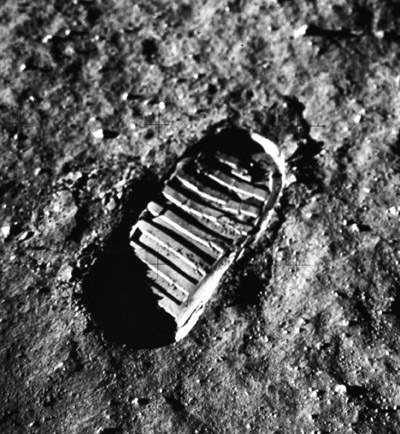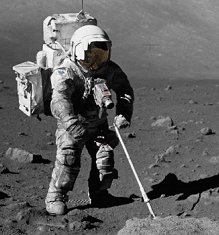The passing of Neil Armstrong the other day brought a flurry of articles and post featuring the same image, one that’s been featured literally uncountable times since 1969. You know the one that I mean…

The iconic print came from Aldrin, and it isn’t even a step per se. Aldrin purposefully found a bare spot and pressed his boot into it, then stepped back and photographed it to demonstrate what the surface was truly like. And that’s kind of interesting in itself. The rock of the lunar surface has been subjected to wide variations of temperature, a few hundred degrees Celsius between day and night, for millions of years, and the drastic expansion and contraction cracked, then pulverized the surface into dust – the technical term is regolith if you enjoy annoying your friends. And no, dust is not simply a euphemism; while many people (including the vapor-brained moon hoaxers) believe the surface is like sand or soil, it’s much finer than that, likened to the consistency of cocoa powder. That image demonstrates it nicely – nothing coarser would have preserved that print so distinctly.
And preserved it may be. With no atmosphere, no wind, no moisture, and nothing at all to disturb it, it may remain that way for quite a long time. It probably still looks exactly like that, despite being 43 years old, and may well continue for thousands of years – eventually, it will crumble under the slow shifting caused by the temperature, and perhaps by micrometeorite strikes. The typical meteors that we see on earth are often no larger than a grain of sand (just moving really damn fast,) and the moon has no atmosphere to slow or annihilate them, so there’s an infinitesimal chance that the print will get pocked by one over any given period of time. That is, of course, if it was not later obscured by other tracks after the photo was taken.

As the first lunar landings were planned, there was no small speculation that the surface would swallow the probes since the depth of the dust was unknown. But just like you don’t sink into the sand at the beach because it compresses and packs, the dust wasn’t the quicksand-like hazard that some scientists speculated was possible. Even the blast of the descending Lunar Excursion Module didn’t blow up much of it, but that was partially because it wasn’t a blast – the LEM had slowed significantly at higher altitudes, and (at 1/6 earth gravity anyway) almost drifted down to the surface, slower than parachutists on earth.
To photographers, that bootprint image at top says something else, too. Notice that it spans the entire light range, pure black in the shadows and pure white in the highlights. While a small portion of this may be due to the compressed dynamic range of computer displays, and might be a bit better on the original negative, most of it is due to the light conditions – this isn’t the result of crappy film. Everything looks lit by a spotlight because there’s no atmosphere to scatter and bounce light around, and the only things reflecting light at a different angle than direct sunlight are the low hills of the lunar landscape, and any nearby introduced stuff like equipment and pressure suits. Since regolith is actually mid-toned, pretty close to 18% grey, this isn’t even evidence of an exposure problem – the range of light levels is simply far wider than film can capture.
By the way, if you want to see more images of any part of our space program, they’re readily available online, and considered public domain since NASA is a government agency – they even provide very high resolution versions. I don’t use the word “hero” lightly, since I think it should denote activities of remarkable altruism and it’s hard for me to consider the space program that way, but I have a tremendous amount of respect (the real meaning of that word) for everyone involved who contributed to these accomplishments.
And besides, it was Buzz who socked Bart Sibrel in the puss…
















































